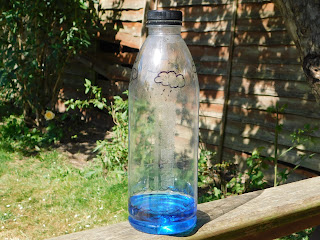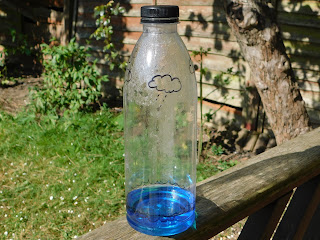My son and I have had a few conversations that have mentioned parts of the water cycle. We've
watched water paintings evaporate and talked about where the water has gone, although water vapour isn't visible! We've also talked a bit about where rain comes from, but we've never put these ideas together into a cycle before. I thought I'd try and make a visual demonstration of how evaporation and condensation in the water cycle works as a means of explaining it a little better to my son.
 |
| Water in the bottom of the bottle |
I went for a quick and simple approach using a plastic bottle before it went in our recycling bin. I drew waves at the bottom to signify the sea and clouds with raindrops at the top with permanent pen. These aren't necessary but I thought they might help make it more memorable for my son.
 |
| Some condensation starting to form |
I put some warm water in the bottom and added a couple of drops of blue food colouring to make it more visible - again, not necessary but a bit easier to see. Warm water is cheating a little, but it does mean the process is a bit quicker and your child is less likely to lose interest before they see anything happening!
We had a look at the bottle, then put it outside in the sunshine. If it's windy, increase the depth of your sea at the bottom as it wasn't very stable and we thought it was going to blow over a couple of times. My son saw tiny droplets of water starting to appear near the top of the bottle, and we talked about how the water in the sea (or puddles, or a lake) was evaporating in the warm sunshine and then it was condensing near the top of the bottle as it rose and cooled.
 |
| 'Rain' beginning to fall |
It took an hour or so before the droplets were big enough to start to run down the bottle like rain. My son wasn't terribly impressed with the rain as it was very slow, but he did watch some droplets run down and told me that they were going back into the sea.
 |
| Larger water droplets started to merge and form 'rain' |
Of course the real water cycle is a little more complex, and this doesn't show the process of rain falling over land and being returned via rivers to the sea. However, it did illustrate some of the basic principles and gives us something to refer back to when we're talking about puddles, evaporation, condensation and rain in future.
Comments
Post a Comment
All comments are moderated before being published.